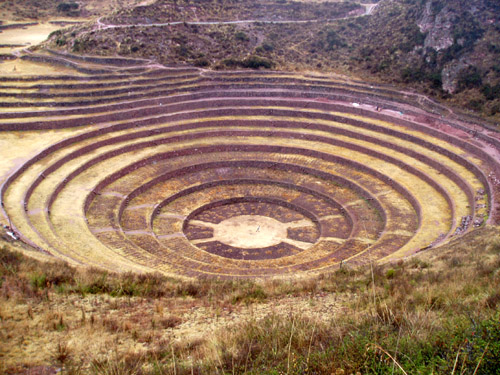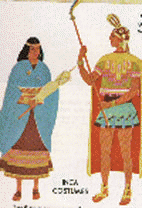
Main article: History of the Incas
According to myth, Incan civilization began with Manco Capac, who carried a golden staff called the ‘tapac-yauri’. The Inca were instructed to create a Temple of the Sun in the spot where the staff sank into the earth, to honor their celestial father. After a long journey, including a tour of the underworld, the Inca arrived at Cuzco, where they built the temple. During the journey, one of Manco’s brothers, and possibly a sister, was turned to stone (huaca) = "sacred/holy". In another version of this legend, instead of emerging from a cave in Cuzco, the siblings emerged from the waters of Lake Titicaca.
In ancient times Inca Virachocha son Mono Linco lived at Pacari-Tampu, today known as Pacaritambo, 25 km (16 mi) south of Cuzco. He and his brothers (Ayar Anca, Ayar Cachi, and Ayar Uchu), and sisters (Mama Ocllo, Mama Huaco, Mama Raua, and Mama Cura) lived near Cuzco at Paccari-Tampu. Uniting their people, and the ten ayllu they encountered in their travels, they set to conquering the tribes of the Cuzco Valley. This legend also incorporates the motif of the golden staff, given to Manco Capac by his father. Accounts vary, but according to some versions, the young Manco jealously betrayed his older brothers, killed them, and thus became the sole ruler of Cuzco.
Emergence and expansion

Inca expansion (1438-1527 AD) The Inca people began as a tribe of the Killke culture in the Cuzco area around the 12th century AD. Under the leadership of Manco Capac, they formed the small city-state of Cuzco (Quechua Qosqo).
In 1438 AD, under the command of Sapa Inca (paramount leader) Pachacuti, much of modern day southern Peru was conquered. Cuzco was rebuilt as a major city and capital of the newly reorganized empire. Known as Tawantinsuyu, it was a federalist system, consisting of a central government with the Inca at its head and four provincial governments with strong leaders: Chinchasuyu (NW), Antisuyu (NE), Contisuyu (SW), and Collasuyu (SE). The powerful Inca emperor is also thought to have built Machu Picchu, either as a family home or as a vacation retreat.
Pachacuti would send spies to regions he had wanted in his empire. They would then report back on the political organization, military might, and wealth. The Sapa Inca would then send messages to the leaders of these lands, extolling the benefits of joining his empire. He offered gifts of luxury goods like high quality textiles, and promised that all living in those territories would be materially richer as subject rulers of the Inca. Most accepted the rule of the Inca as a fait accompli and acquiesced peacefully. The neighboring rulers' children would be brought to Cuzco to be taught about Inca administration systems, and then would return to rule their native lands. This allowed the Inca to indoctrinate the former rulers' children into the Inca nobility, and, with luck, marry their daughters into families at various corners of the empire.
It was traditional for the Inca's son to lead the army; Pachacuti's son Túpac Inca began conquests to the north in 1463, continuing them as Inca after Pachucuti's death in 1471. His most important conquest was the Kingdom of Chimor, the Inca's only serious rival for the coast of Peru. Túpac Inca's empire stretched north into modern day Ecuador and Colombia, and his son Huayna Cápac added significant territory to the south. At its height, Tawantinsuyu included Peru and Bolivia, most of what is now Ecuador, a large portion of modern-day Chile, and extended into corners of Argentina and Colombia.
Tawantinsuyu was a patchwork of languages, cultures and peoples. The components of the empire were not all uniformly loyal, nor were the local cultures all fully integrated. For example, the Chimú used money in their commerce, while the Inca empire as a whole had an economy based on exchange and taxation of luxury goods and labor. (It is said that Inca tax collectors would take the head lice of the lame and old as a symbolic tribute.) The portions of the Chachapoya that had been conquered were almost openly hostile to the Inca, and the Inca nobles rejected an offer of refuge in their kingdom after their troubles with the Spanish. They ended up being conquered by Francisco Pizarro.
Spanish conquest and Vilcabamba

Main article: Spanish conquest of the Inca Empire
Spanish conquistadors led by Francisco Pizarro explored south from Panama, reaching Inca territory by 1526. It was clear that they had reached a wealthy land with prospects of great treasure. After one more expedition in 1529, Pizarro returned to Spain and received royal approval to conquer the Inca region and become its viceroy.
At the time the Spanish returned to Peru in 1532, a war of succession between Huayna Capac's son Huascar and half brother Atahualpa was in full swing. Additionally, unrest among newly conquered territories, and smallpox, spreading from Central America, had considerably weakened the empire. The Spanish invaders told the Inca that the diseases decimating their population were sent from the Christian god as punishment for their idolatrous ways.
Pizarro did not have a formidable force. With just 180 men, 27 horses and 1 cannon, he often used diplomacy to talk his way out of potential confrontations that could have easily ended in defeat. Their first engagement was the Battle of Puná (near present-day Guayaquil, Ecuador) where his forces rapidly overcame the indigenous warriors of Puná Island. Pizarro then founded the city of Piura in July 1532. Hernando de Soto was sent inland to explore the interior; he returned with an invitation to meet Atahualpa, who had defeated his half brother in the civil war and was resting at Cajamarca with his army of 80,000 troops.
Pizarro met with the Inca, who had brought only a small retinue. Through interpreters, Pizarro requested the new Inca ruler convert to Christianity. A disputed legend claims that Atahualpa was handed a Bible and threw it on the floor. The Spanish supposedly interpreted this action as reason for war. Though some chroniclers suggest that Atahualpa simply did not understand the notion of a book, others portray Atahualpa as being genuinely curious and inquisitive in the situation. Regardless, the Spanish attacked the Inca's retinue, capturing Atahualpa.
Atahualpa offered the Spaniards enough gold to fill the room he was imprisoned in, and twice that amount in silver, in order to be freed. The Incas fulfilled this ransom, but Pizarro refused to release him. During Atahualpa's imprisonment Huascar was assassinated. The Spanish maintained it was at Atahualpa's orders, and this was one of the charges used against Atahualpa when the Spanish finally decided to put him to death in August 1533.
The Spanish installed his brother, Manco Inca Yupanqui, upon the Empire's throne. Yupanqui cooperated with the Spaniards while the conquistadors fought to put down resistance in the north. Meanwhile an associate of Pizarro's, Diego de Almagro, attempted to claim Cuzco for himself. Yupanqui attempted to use this intra-Spanish feud to his advantage, recapturing Cuzco in 1536, but the Spanish retook the city.
Manco Inca Yupanqui then retreated to the mountains of Vilcabamba, where he and his successors ruled for another 36 years, sometimes raiding the Spanish or inciting revolts against them. In 1572 the last Inca stronghold was discovered, and the last ruler, Túpac Amaru, Manco's son, was captured and executed, bringing the Inca Empire to an end.










